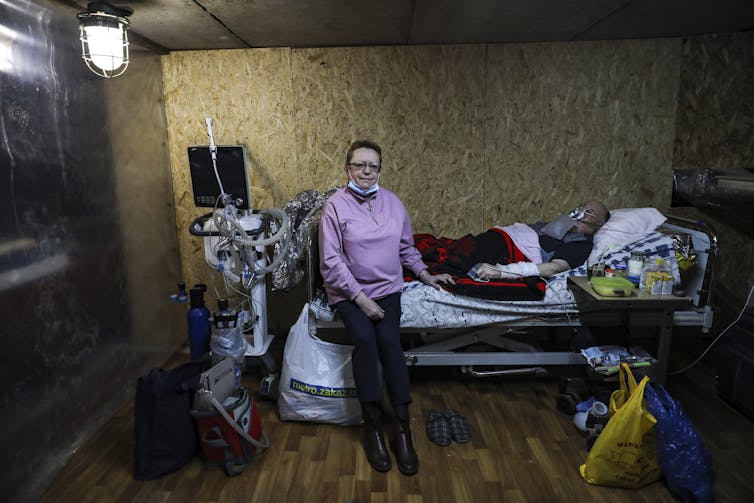Russia’s invasion of Ukraine has already – and will continue to have – extraordinary health and socioeconomic consequences for the Ukrainian people. One of those consequences will almost certainly be an increased COVID burden.
Ukraine reported 37,000 new COVID cases on February 10, 2022 – the country’s highest daily total since the beginning of the pandemic. Since COVID emerged, Ukraine has had more than 5 million confirmed cases and more than 100,000 deaths. Over a million of those cases have occurred since the beginning of 2022, and with infections climbing sharply in February, deaths were rising too.
However, following the invasion, Ukraine’s data reporting initially slowed down before stopping altogether. There’s now no record of how COVID is progressing in the country; from here onwards all case and death statistics will be an under-count. What is clear is that the war started at a time when COVID was plainly on the rise.
Compounding this problem is the fact that the country’s COVID vaccine coverage is low, with just 36% of the population having received one or more vaccine doses. So a high proportion of Ukrainians remain susceptible not only to catching COVID, but also to the potential consequences of hospitalisation and death, which are far more likely in the unvaccinated.
Thus, even in peaceful times, there would be cause for concern about how the relatively fragile health systems in Ukraine might manage further waves of COVID infections. Providing healthcare in a conflict situation is even more difficult, and outbreaks will be almost impossible to control as people seek safety in any way they can.
Optimal conditions for transmission
As of mid-March 2022, an estimated 3 million Ukraine residents have fled their country. Humanitarian groups and health agencies who look after refugee health are therefore likely to be receiving large numbers of people unvaccinated or partially vaccinated against COVID. On top of this, there are already are high levels of COVID around Europe, and the coronavirus burden among Ukrainians, while essentially unknown, is likely to be significant.

The most recently reported test-positivity value for Ukraine (the proportion of COVID tests taken that are positive) was 60% on February 18, 2022. This is an incredibly high value, and indicates that there were already uncontrolled outbreaks around the country before the war started. It suggests that even when case numbers recently hit record highs, they were likely being under-counted by a significant margin.
All told, this means that people vulnerable to the worst effects of COVID are mixing in groups in which there’s likely to be lots of the virus circulating. Being displaced or sheltering from the conflict will then add to this risk.
The refugee emergency accommodation in neighbouring countries, with necessarily dozens or hundreds of beds in one room, provide some basic shelter and respite for refugees. However, crowded indoor settings provide an ideal space for respiratory infectious diseases to thrive. Transmission of coronaviruses is likely, with other infections such as influenza or tuberculosis also a potential public health concern. There’s also likely to be observed increases in several other infectious disease outbreaks, ranging from diarrhoea to scabies.
Measles, though, is perhaps the best analogue for COVID in this situation. It is a highly infectious respiratory virus that is often severe in unvaccinated children, and outbreaks are very common where routine healthcare is interrupted, such as in humanitarian crises and areas of conflict.

The basic reproduction number (R0) of measles – that is, how many people on average an infected person will go on to infect in a susceptible population – is often estimated at between 12 and 18. Omicron’s R0 is still being worked out, but the variant is known to be more infectious than previous ones. One estimate puts omicron’s R0 at 8.2. Because it spreads easily, the potential for outbreaks in conflict zones and refugee shelters is high, like with measles.
The risk of another variant
An additional factor to consider is that the greater the number of COVID cases, the greater the risk that new variants may emerge. The delta variant almost certainly emerged from the catastrophe that was India’s spring wave in 2021, which led to hundreds of thousands, if not millions, of COVID deaths. The alpha and beta variants are thought to have arisen in the UK and South Africa respectively, at times of uncontrolled outbreaks. With each new variant there are new risks, for example around vaccine effectiveness.
The unfolding tragedy that we see in Ukraine threatens the efforts the world has made to counter this novel coronavirus. Displaced and refugee populations need support, not just in Ukraine but elsewhere too, for example in Tigray or the Afghan refugees who have fled the Taliban regime. Bringing the COVID pandemic under control requires global cooperation around public health as well as highly vaccinated populations across all corners of the globe.


